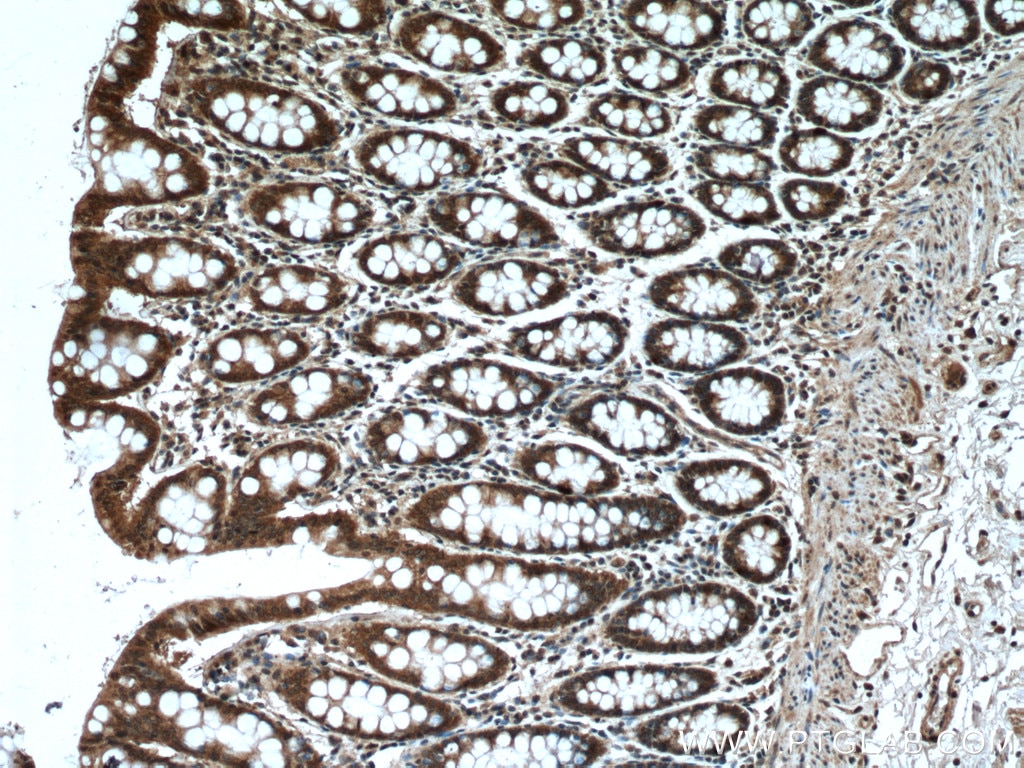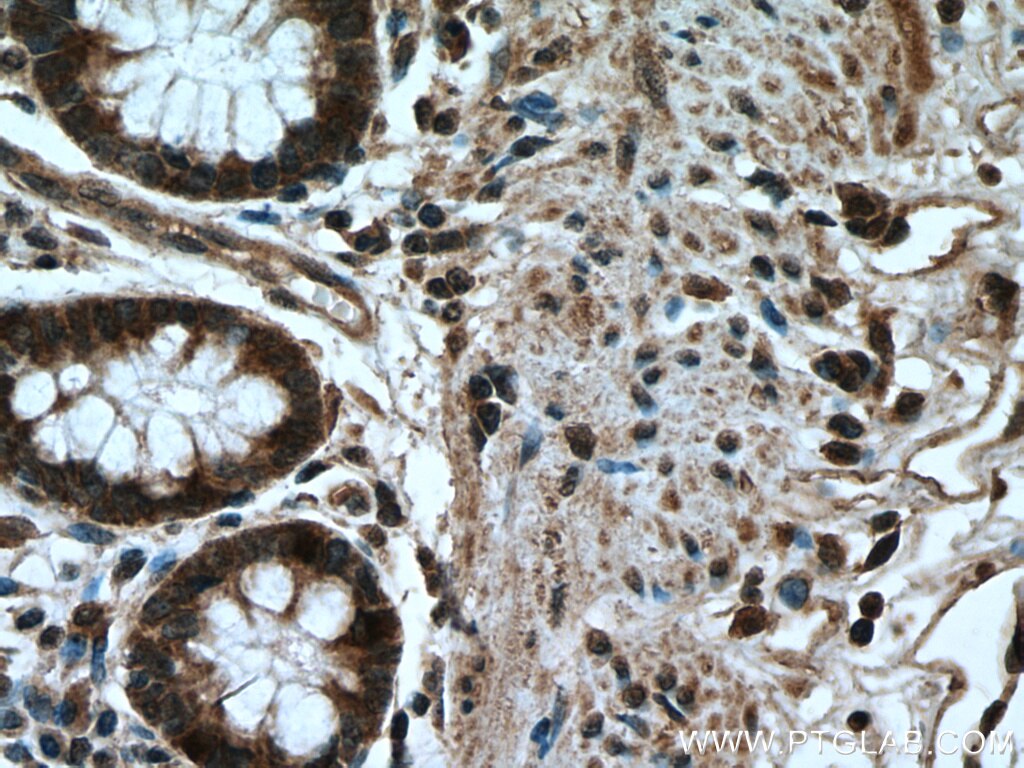Tested Applications
| Positive WB detected in | HeLa cells, HT-1080 cells, HEK-293T cells |
| Positive IHC detected in | human colon tissue Note: suggested antigen retrieval with TE buffer pH 9.0; (*) Alternatively, antigen retrieval may be performed with citrate buffer pH 6.0 |
Recommended dilution
| Application | Dilution |
|---|---|
| Western Blot (WB) | WB : 1:1000-1:6000 |
| Immunohistochemistry (IHC) | IHC : 1:50-1:500 |
| It is recommended that this reagent should be titrated in each testing system to obtain optimal results. | |
| Sample-dependent, Check data in validation data gallery. | |
Published Applications
| KD/KO | See 1 publications below |
| WB | See 18 publications below |
| IHC | See 2 publications below |
| IP | See 1 publications below |
Product Information
16541-1-AP targets AXIN1 in WB, IHC, IP, ELISA applications and shows reactivity with human samples.
| Tested Reactivity | human |
| Cited Reactivity | human, rat, chicken |
| Host / Isotype | Rabbit / IgG |
| Class | Polyclonal |
| Type | Antibody |
| Immunogen |
CatNo: Ag9858 Product name: Recombinant human AXIN1 protein Source: e coli.-derived, PGEX-4T Tag: GST Domain: 1-351 aa of BC044648 Sequence: MNIQEQGFPLDLGASFTEDAPRPPVPGEEGELVSTDPRPASYSFCSGKGVGIKGETSTATPRRSDLDLGYEPEGSASPTPPYLKWAESLHSLLDDQDGISLFRTFLKQEGCADLLDFWFACTGFRKLEPCDSNEEKRLKLARAIYRKYILDNNGIVSRQTKPATKSFIKGCIMKQLIDPAMFDQAQTEIQATMEENTYPSFLKSDIYLEYTRTGSESPKVCSDQSSGSGTGKGISGYLPTLNEDEEWKCDQDMDEDDGRDAAPPGRLPQKLLLETAAPRVSSSRRYSEGREFRYGSWREPVNPYYVNAGYALAPATSANDSEQQSLSSDADTLSLTDSSVDGIPPYRIRKQ Predict reactive species |
| Full Name | axin 1 |
| Calculated Molecular Weight | 826aa,92 kDa; 862aa,95 kDa |
| Observed Molecular Weight | 100-110 kDa |
| GenBank Accession Number | BC044648 |
| Gene Symbol | AXIN1 |
| Gene ID (NCBI) | 8312 |
| RRID | AB_2062409 |
| Conjugate | Unconjugated |
| Form | Liquid |
| Purification Method | Antigen affinity purification |
| UNIPROT ID | O15169 |
| Storage Buffer | PBS with 0.02% sodium azide and 50% glycerol, pH 7.3. |
| Storage Conditions | Store at -20°C. Stable for one year after shipment. Aliquoting is unnecessary for -20oC storage. 20ul sizes contain 0.1% BSA. |
Background Information
Axis inhibition protein1 (AXIN1), also called AXIN, together with AXIN2 are multidomain scaffold proteins that negatively regulate Wnt signaling. AXIN1 is likely to function as a tumor suppressor. Under UV irradiation, AXIN1-HIPK2-TP53 complex forms. The complex also controls cell growth, apoptosis and development. Like AXIN2, AXIN1 undergoes poly(ADP-ribosy)lation by tankyrase TNKS and TNKS2 followed by unbiquitination by RNF146 which leads to its degradation and subsequent activation of Wnt signaling. Its deubiquitination by USP34 is important for nuclear accumulation during Wnt signaling. Recent researches find that CircAXIN1 encodes a novel protein, AXIN1-295aa, which shows at around 40-55 kDa by Western Blot. AXIN1-295aa functions as an oncogenic protein, activating the Wnt signaling pathway to promote GC tumorigenesis and progression, suggesting a potential therapeutic target for GC. Proteintech's AXIN1 antibody 16541-1-AP is a rabbit polyclonal antibdy raised against the N-terminus of human AXIN1.
Protocols
| Product Specific Protocols | |
|---|---|
| IHC protocol for AXIN1 antibody 16541-1-AP | Download protocol |
| WB protocol for AXIN1 antibody 16541-1-AP | Download protocol |
| Standard Protocols | |
|---|---|
| Click here to view our Standard Protocols |
Publications
| Species | Application | Title |
|---|---|---|
Int J Mol Sci AXIN2 Reduces the Survival of Porcine Induced Pluripotent Stem Cells (piPSCs). | ||
Front Oncol Targeting TRIM54/Axin1/β-Catenin Axis Prohibits Proliferation and Metastasis in Hepatocellular Carcinoma. | ||
Cancer Gene Ther Stabilizing and upregulating Axin with tankyrase inhibitor reverses 5-fluorouracil chemoresistance and proliferation by targeting the WNT/caveolin-1 axis in colorectal cancer cells. | ||
Commun Biol Tankyrase-1-mediated degradation of Golgin45 regulates glycosyltransferase trafficking and protein glycosylation in Rab2-GTP-dependent manner. | ||
Exp Cell Res The transcript ENST00000444125 of lncRNA LINC01503 promotes cancer stem cell properties of glioblastoma cells via reducing FBXW1 mediated GLI2 degradation. | ||
FEBS Lett Exosomes derived from mineralizing osteoblasts promote ST2 cell osteogenic differentiation by alteration of microRNA expression. |












